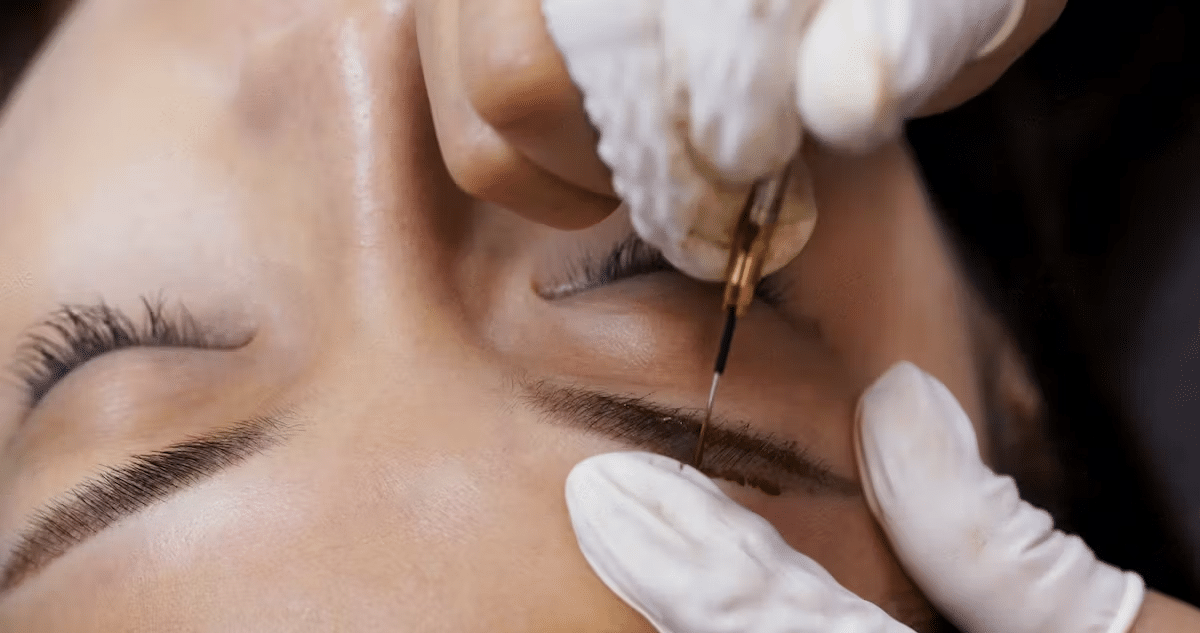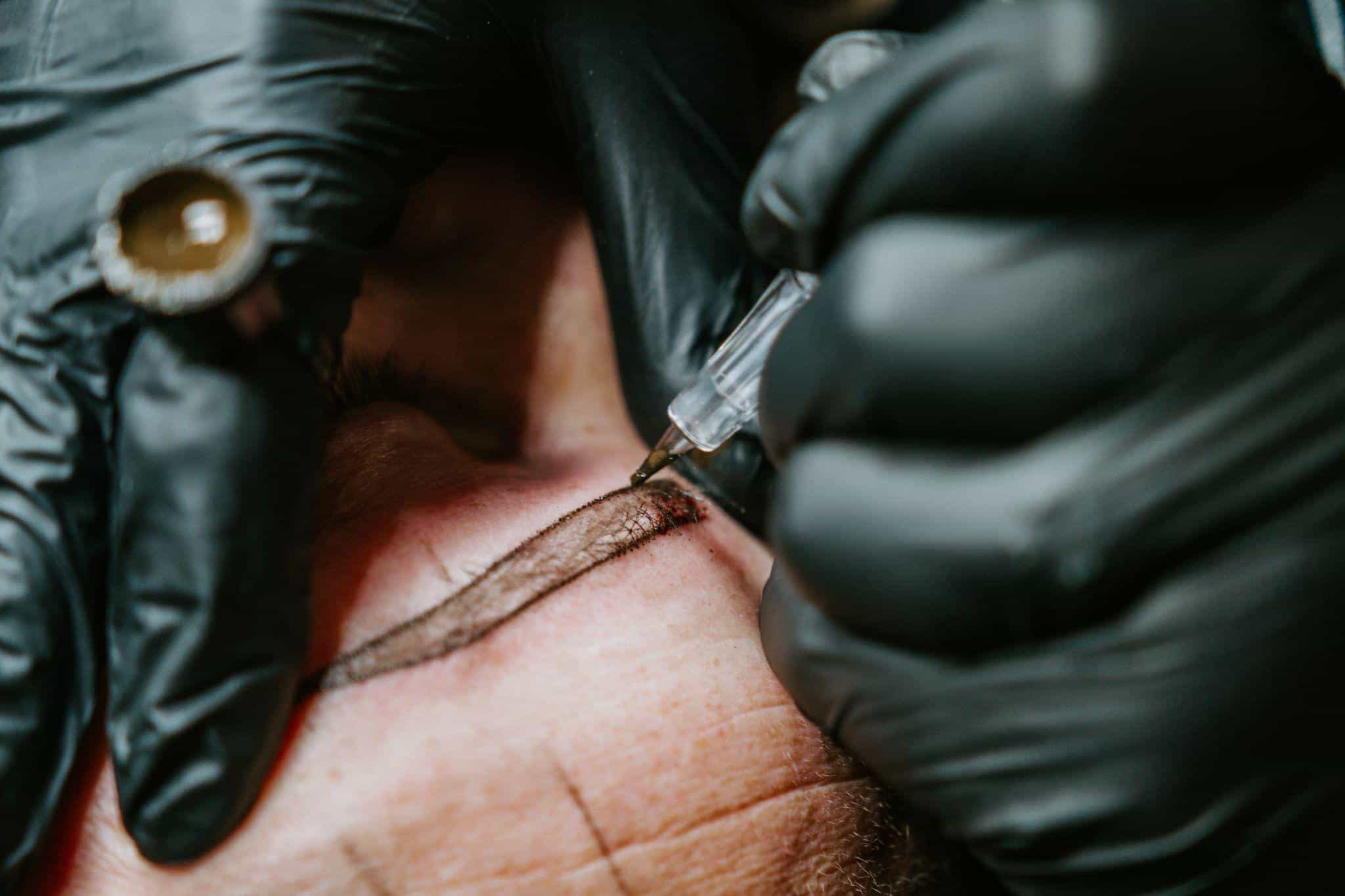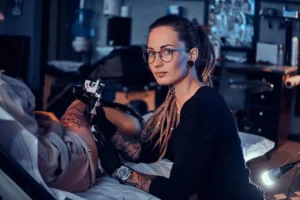 Eyebrow tattoos
Eyebrow tattoos have been gaining popularity as a
long-term solution for fuller-looking eyebrows. However, not all tattoos age well, and some may even become a regret. Fortunately, with the latest advancements in tattoo removal techniques, removing unwanted eyebrow tattoos effectively is now possible.
This blog will explore the various eyebrow tattoo removal techniques and aftercare tips to ensure optimal healing. Say goodbye to your old eyebrow tattoo, and hello to a fresh start!
Popularity Of Eyebrow Tattoos
Eyebrow tattoos, also known as microblading, have become increasingly popular in recent years due to their ability to enhance the appearance of eyebrows by adding shape, fullness, and definition. They are particularly popular among people with thinning or sparse eyebrows or who want to achieve a certain eyebrow shape without daily makeup application.
The procedure involves using a small blade or needle to deposit ink into the skin to mimic the look of individual eyebrow hairs. Eyebrow tattoos can last for up to two years. Still, as with any tattoo, some people may eventually want to have them removed or faded for various reasons, such as changing preferences or dissatisfaction with the results. This is where effective removal techniques come into play.
Effective Eyebrow Tattoo Removal Techniques

There are various effective techniques for removing eyebrow tattoos, each with advantages and disadvantages. The most commonly used
techniques include laser, microblading, and saline removal. Let’s look at them in more detail:
Laser Removal
Laser removal is a popular and effective technique for removing eyebrow tattoos. During the procedure, a high-powered laser breaks up the pigment particles in the tattoo. The body’s immune system then works to remove the pigment over time.
Multiple sessions may be required for complete removal, which can be painful. However, topical numbing creams can be used to minimise discomfort. Choosing a licensed and experienced technician to remove the laser is important to ensure the best possible outcome.
Saline Removal
Saline removal is another effective brow tattoo technique involving a saline solution to remove the pigment from the skin. This technique involves using a small tattoo needle to create tiny incisions in the skin, which are then filled with a saline solution. The salt in the solution draws out the pigment, and the body’s immune system helps to remove it over time.
Saline removal is the safest, most gentle and most natural approach to tattoo removal, and it is often preferred by people who have sensitive skin or want to avoid the potential side effects of laser removal. However, removing an eyebrow tattoo using saline can take several sessions and may not be as effective on certain ink colours.
Working with a trained and experienced technician for saline removal is important, as improper technique can lead to scarring or discolouration of the skin. Aftercare is also crucial to ensure proper healing and minimise the risk of infection.
Combined Microneedling Treatments
Microneedling can be used in conjunction with other treatments to remove microblading. Skin is perforated with thin needles to allow products to penetrate more effectively.
The texture of your skin will improve as you heal and regenerate. Microneedling can also treat fine lines, wrinkles, and scars on the skin. In recent years, it has become increasingly popular as a means of removing microblading.
Exfoliating Chemicals
You are already aware of the cost of removing micro-bladed eyebrows. You can do a budget-friendly alternative to expensive treatments at home – if your brow problem is minor.
With chemical exfoliators, you can lighten your microblading results faster by removing dead skin cells and stimulating new cell growth. Use an alpha hydroxy acids (AHA) or beta hydroxy acids (BHA) exfoliator after your eyebrows fully heal.
Tattoo Removal Creams
Many tattoo removal creams are available on the market, and many people use them. These methods aren’t safe or effective; sometimes, they even harm rather than help.
Generally, microblading removal creams contain glycolic acid and hydroquinone, ingredients in dark-spot correctors. Even though it can exfoliate your skin’s outer layer and cause it to peel and fade the pigment, it cannot reach the ink deposited in deeper layers.
The Waiting Game
Waiting out is an ideal solution in cases where microblading is not botched. You can let the pigments fade naturally if your brow problem is very minimal and can be corrected with makeup.
If the pigments aren’t fading properly or as quickly as you want, a professional microblading eyebrows removal treatment may be the more effective solution.
Preparing For Eyebrow Tattoo Removal

Preparing for eyebrow tattoo removal is
essential to ensure a successful procedure. It involves consulting with a qualified professional specialising in tattoo removal to discuss the process, the number of sessions needed, and any risks or complications. Before the procedure, the tattooed area should be thoroughly cleaned, and any makeup or skincare products should be avoided.
It is also important to avoid sun exposure, smoking, and alcohol consumption, as they can affect the skin’s healing process. Proper preparation can minimise discomfort and increase the chances of a successful outcome.
Aftercare For Microblading Removal
Aftercare is crucial for proper healing and reducing the risk of complications after eyebrow tattoo removal. Here are some
aftercare tips:
- Keep the treated area clean and dry. Avoid soaking it in water for at least 24 hours after the procedure.
- Apply a thin layer of ointment or cream your technician recommends to the treated area to keep it moist and promote healing.
- Avoid exposing the treated area to direct sunlight or tanning beds.
- Avoid picking or scratching the scabs that may form on the treated area. Let them fall off naturally.
- Avoid strenuous activities or exercise that can cause sweating for at least 24 hours after the procedure.
- Follow the aftercare instructions provided by your technician to ensure proper healing.
- If you experience any redness, swelling, or signs of infection, contact your technician or healthcare provider immediately.
Following these aftercare tips can help ensure the best possible results and minimise the risk of complications after eyebrow tattoo removal.
Conclusion
Removing an old eyebrow tattoo can be daunting, but it is possible with the right techniques and professional help. Researching and choosing a reputable and experienced technician for the best results is essential. The different removal techniques discussed in this blog, such as laser removal, saline removal, and dermabrasion, offer effective ways to remove eyebrow tattoos.
Following the aftercare instructions is crucial to promote healing and reduce the risk of scarring or infection. If you’re considering removing your eyebrow tattoo, don’t hesitate to consult with a professional and explore your options to achieve the best possible results.
FAQS
Can eyebrow tattoo removal cause scarring?
There is a risk of scarring with any tattoo removal method,
but the risk is lower with non-laser methods such as saline removal and microblading.
How long should I wait to get another eyebrow tattoo after removal?
Waiting
at least 6-12 months after eyebrow tattoo removal before getting a new tattoo is recommended to allow the skin to heal fully. Choosing a reputable and experienced tattoo artist is also important to avoid going through the removal process again.
How long does it take to remove an eyebrow tattoo?
The time it takes to remove an eyebrow tattoo depends on the method and ink depth. Laser removal usually takes
6-10 sessions, while saline removal and microblading can take 3-5 sessions each.
 Eyebrow tattoos have been gaining popularity as a long-term solution for fuller-looking eyebrows. However, not all tattoos age well, and some may even become a regret. Fortunately, with the latest advancements in tattoo removal techniques, removing unwanted eyebrow tattoos effectively is now possible.
This blog will explore the various eyebrow tattoo removal techniques and aftercare tips to ensure optimal healing. Say goodbye to your old eyebrow tattoo, and hello to a fresh start!
Eyebrow tattoos have been gaining popularity as a long-term solution for fuller-looking eyebrows. However, not all tattoos age well, and some may even become a regret. Fortunately, with the latest advancements in tattoo removal techniques, removing unwanted eyebrow tattoos effectively is now possible.
This blog will explore the various eyebrow tattoo removal techniques and aftercare tips to ensure optimal healing. Say goodbye to your old eyebrow tattoo, and hello to a fresh start!
 There are various effective techniques for removing eyebrow tattoos, each with advantages and disadvantages. The most commonly used techniques include laser, microblading, and saline removal. Let’s look at them in more detail:
There are various effective techniques for removing eyebrow tattoos, each with advantages and disadvantages. The most commonly used techniques include laser, microblading, and saline removal. Let’s look at them in more detail:
 Preparing for eyebrow tattoo removal is essential to ensure a successful procedure. It involves consulting with a qualified professional specialising in tattoo removal to discuss the process, the number of sessions needed, and any risks or complications. Before the procedure, the tattooed area should be thoroughly cleaned, and any makeup or skincare products should be avoided.
It is also important to avoid sun exposure, smoking, and alcohol consumption, as they can affect the skin’s healing process. Proper preparation can minimise discomfort and increase the chances of a successful outcome.
Preparing for eyebrow tattoo removal is essential to ensure a successful procedure. It involves consulting with a qualified professional specialising in tattoo removal to discuss the process, the number of sessions needed, and any risks or complications. Before the procedure, the tattooed area should be thoroughly cleaned, and any makeup or skincare products should be avoided.
It is also important to avoid sun exposure, smoking, and alcohol consumption, as they can affect the skin’s healing process. Proper preparation can minimise discomfort and increase the chances of a successful outcome.




